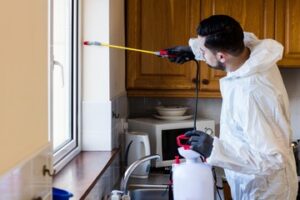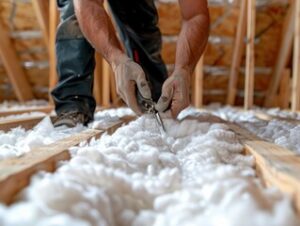Springfield MO Pest Control involves monitoring, identifying and controlling pests. It can be done for continuous (constantly present) and sporadic or potential pests.

Rodents such as rats and mice chew wires, contaminate food and can carry disease causing bacteria like Hantavirus Pulmonary Syndrome and leptospirosis. Squirrels strip insulation from electrical wiring and can damage structures and cause fires.
Pests cause damage to buildings, crops and gardens and can also threaten people’s health. They can carry bacteria and viruses that can make people sick. Some have a frightening or grotesque appearance and can bite or sting humans, like bees, ants, cockroaches and ticks. Their droppings, faeces and body parts can contaminate food, affect indoor air quality and trigger asthma attacks. They can also destroy books, manuscripts and other materials in libraries.
Prevention is an essential part of pest control and involves removing the conditions that attract unwanted pests. It can include physical barriers, such as fences or screens, that stop pests from getting into buildings. It can also include eliminating their nests and removing food and water sources. This prevents them from developing an infestation and stopping it from getting worse.
Some forms of pest control are purely physical, such as setting traps and bait stations for rodents and insects. These work best when they are targeted to the particular species and placed in the most likely places for them to be found. They must be regularly checked and the baits or traps replaced to ensure they are effective.
Other physical methods of pest control include weeding and lawn maintenance to remove the plants that pests like to feed on. It can also help to trim shrubs and trees, and to remove vines and ivy that can climb up walls or the roof of a building. These measures can reduce the number of pests, and they can also help to eliminate the moisture that leads to mould growth, which is another problem that can be caused by pests.
Chemical control is more drastic and involves spraying the area with chemicals that kill or repel the pests. It can be used to protect against some of the most serious threats, such as termites and cockroaches, but it is not suitable for all types of pests and should only be used in conjunction with other methods of pest control. It is particularly important to use chemicals sparingly in library settings, where the toxicity of these substances can be a major concern for the safety of readers and staff.
Suppression
Pests are annoying at the very least and if not dealt with in time can cause major problems like health issues, property damage and even loss of life. It is therefore crucial to hire experts for pest control, who are trained in the different methods of eradicating these unwanted creatures like rodents, cockroaches, termites and even bees or wasps.
Suppression as a part of pest control is usually done in conjunction with prevention or at the very last resort when all other measures have failed. This typically involves spraying the affected area with chemicals that either kill or repel the pests. This method of pest control is generally viewed with some suspicion by consumers because of its potential health risks but reputable providers take the necessary precautions to minimize any risk.
During the suppression phase, food manufacturers should regularly inspect all food processing environments for signs of pests. This is to ensure that the food being produced does not come into contact with any of the pests or their droppings as this could cause biological/physical contamination. The presence of pests can also affect the quality of the food or its wholesomeness. It is recommended that a pest sighting register be kept which records all findings from both the food manufacturer and the contracted pest control company.
Pests that can be found in most food manufacturing environments include small mammals (e.g. black and brown rats and mice), crawling insects (e.g. cockroaches, ants and beetles), flying insects (e.g. houseflies and fermentation flies) and birds (e.g. seagulls and pigeons).
In addition to the above, pests such as rodents, cockroaches and ants have been shown to have a negative impact on indoor air quality by contaminating food and releasing substances that can trigger asthma and allergic reactions in people. This is why it’s important that all food service premises, hospitality buildings and offices, healthcare facilities, schools and colleges, office blocks and other commercial locations have a fully functioning pest management plan in place. This plan should encompass preventative measures such as keeping a clean work environment, reporting maintenance issues to the building owner/manager and monitoring air quality. It should also include an emergency response protocol such as pesticide fumigation.
Biological Control
Biological control uses predators, parasitoids, pathogens or competitors to suppress unwanted insects, mites, weeds and disease organisms without using harmful chemicals. Time honored approaches are being adapted to meet today’s pest management challenges. NIFA supports research in this area because it helps us find safer, more effective methods of controlling pests while reducing our reliance on synthetic pesticides.
NIFA is currently supporting research in biologically-based pest control technologies that can be used to control a broad range of organisms. Biological control is an integral part of IPM and often works in conjunction with other tactics. Biologically-based pest control techniques use naturally occurring organisms (e.g., parasitic wasps or fungi) that target pest species and are then introduced into fields or gardens. These organisms then prey on or parasitize the unwanted pest organism, thereby reducing its population to an acceptable level.
The most common type of biological control is called augmentation. This is where natural enemies are brought into the field to supplement populations that are already present there, often in small, repeated releases or one ‘big wave’ approach called inundative release. Augmentative biocontrol is most commonly used to address slow-moving pests such as aphids or mites, and it is primarily suited for organic agriculture, home gardening and enclosed spaces such as greenhouses.
Importation or classical biological control is the other main method of biological control. This occurs when a pest from another continent is introduced into our country or region accidentally or on purpose, and it rapidly grows out of control due to the lack of predators, parasitoids, diseases and herbivores to keep it in check. To overcome this problem, governments sponsor expeditions to the area of origin of the pest to search out and bring back its natural enemies for release in the new environment.
It takes several generations for a classical biocontrol agent to become fully established in the field and provide long-term control of the pest. In addition, any newly-developed classical biocontrol agents must undergo rigorous testing and quarantine in order to ensure that they are safe for human food and other crops, do not have adverse effects on native ecosystems and are actually capable of controlling the targeted pest.
Chemical Control
The use of chemical pesticides is a common method of eradicating pests. This method usually involves spraying or dropping the chemicals into infested areas. The use of chemicals in this process is not without risk, however, and it is important to use them sparingly and responsibly. It is also important to use only approved pesticides and to follow all of the product’s instructions and safety warnings.
There are many different types of chemical pesticides, and each one has a specific active ingredient. These are tested in laboratories to determine how much of the active ingredient is required to kill a specific species of animal, known as the lethal dose or LD 50. The LD 50 figure is then used to determine how much of the pesticide can be safely applied to an area.
While pesticides do offer decent efficiency, they have a high ecological impact and often require more poison to kill the same amount of animal. Also, animal species are evolving to become resistant to the old chemicals, making them less effective over time.
For these reasons, companies that employ professional pest control services are increasingly opting for biological methods of pest management. In general, pesticides should be used only when all other options have been exhausted, and even then, their use should be minimized as much as possible.
Biological pest controls work to replace the natural enemy of a particular pest, which can be more effective than simply killing the pest directly. This method has several advantages over other forms of pest control, including lower environmental impact, fewer human health risks, and the ability to provide long-term results.
Another advantage of biological pest controls is that they can be used for a wide variety of pests, from small mammals (e.g., Black and Brown rats and mice) to wood-destroying organisms and insects. Some of the most important biological pest control strategies include the use of parasitoids, pheromones, and plant extracts.
Commercial facilities such as office buildings, food service establishments, hotels and sports turf, all need to be protected against a range of common pest species. These can pose serious health and safety issues for employees and customers, so pest control measures need to be robust and effective.
